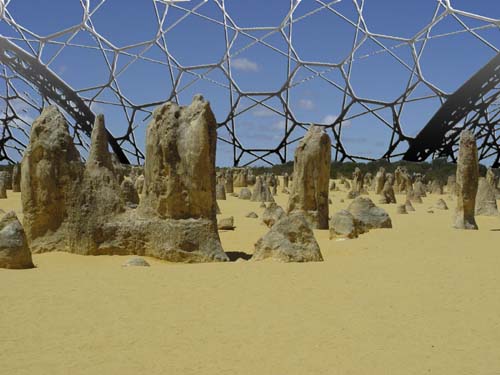|

Postcards
From Eden
Postcard 6
Edition of 40
Photographic montage
5" x 7"
Original image - Pinnacles Nambung National Park
Cervantes Western Australia
In
the Pinnacles Desert, right in the heart of Nambung National Park,
thousands of huge limestone pillars rise out of a stark landscape
of yellow sand. In places they reach up to three and a half metres
tall. Some are jagged, sharp-edged columns, rising to a point;
while others resemble tombstones. The raw material for the limestone
of the pinnacles came from sea shells in an earlier epoch rich
in marine life. These shells were broken down into lime-rich sands
which were brought ashore by waves and then carried inland by
the wind to form high, mobile dunes. Three old systems of sand
dunes run parallel to the WA coast, marking ancient shorelines.
The oldest of these, known as the Spearwood dune system, is characterised
by yellow or brownish sands. In winter, rain, which is slightly
acidic, dissolves small amounts of calcium carbonate as it percolates
down through the sand. As the dune dries out during summer, this
is precipitated as a cement around grains of sand in the lower
levels of the dunes, binding them together and eventually producing
a hard limestone rock, known as Tamala Limestone.
At the same time, vegetation that became established on the surface,
aided this process.
Plant roots stabilised the surface, and encouraged a more acidic
layer of soil and humus (containing decayed plant and animal matter)
to develop over theremaining quartz sand.
The acidic soil accelerated the leaching process, and a hard layer
of calcrete formed over the softer limestone below. Cracks which
formed in the calcrete layer were exploited by plant roots. When
water seeped down along these channels, the softer limestone beneath
was slowly leached away and the channels gradually filled with
quartz sand. This subsurface erosion continued until only the
most resilient columns remained. The Pinnacles, then, are the
eroded remnants of the formerly thick bed of limestone.
|
|
|